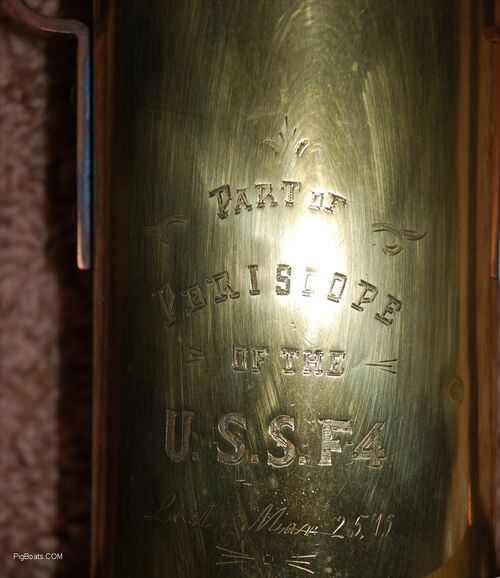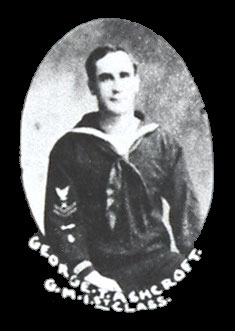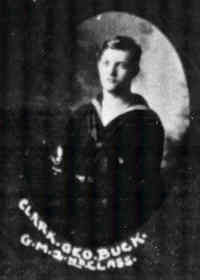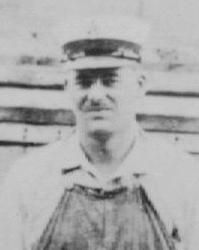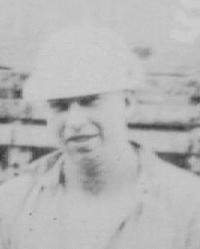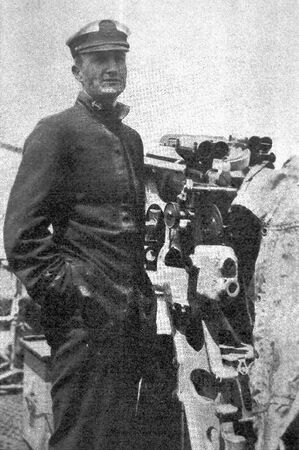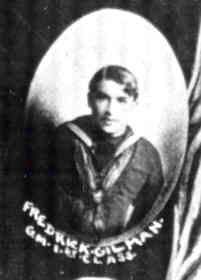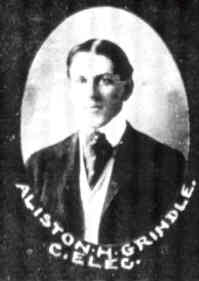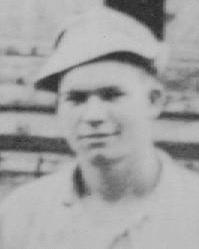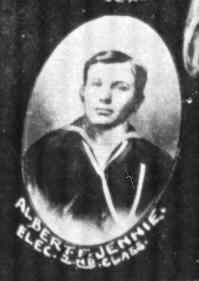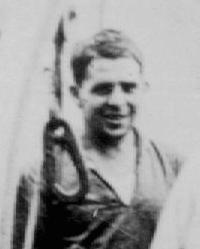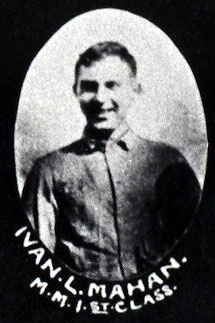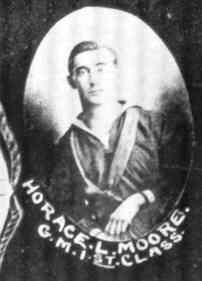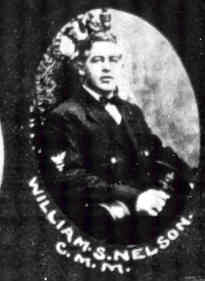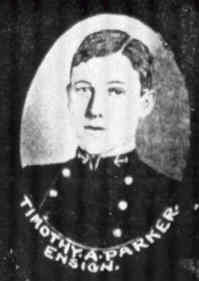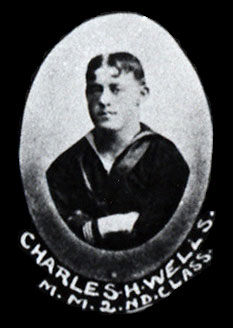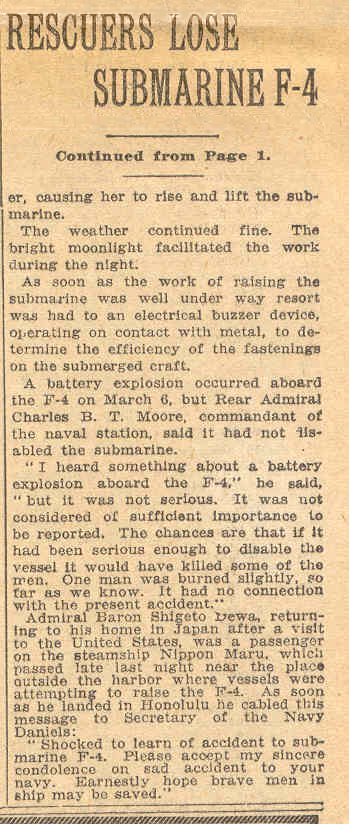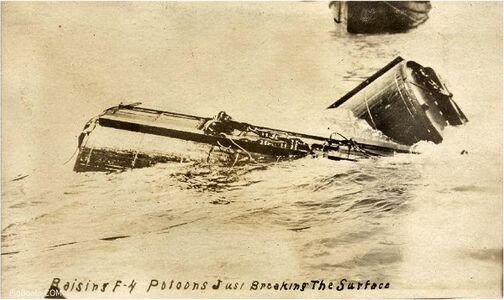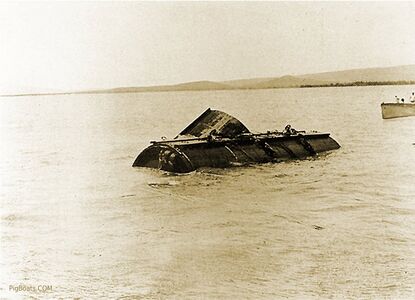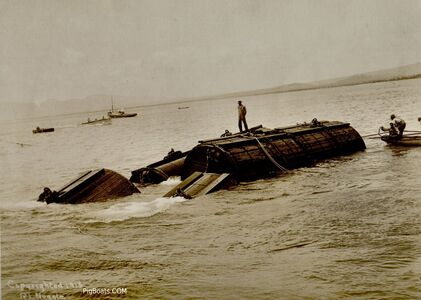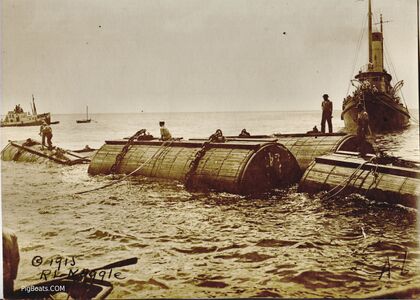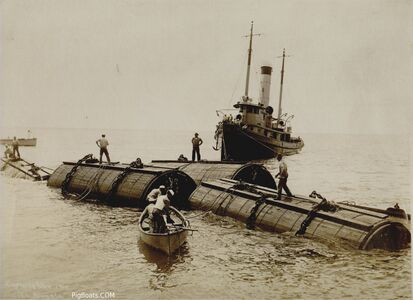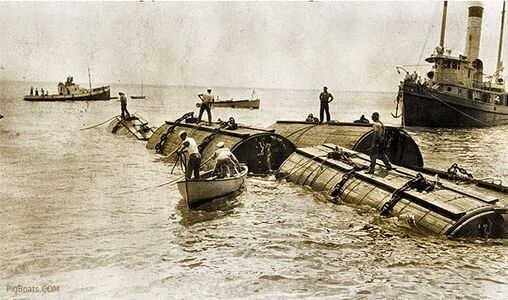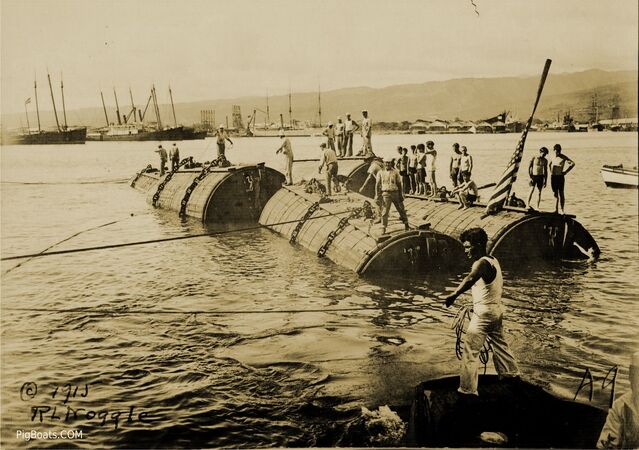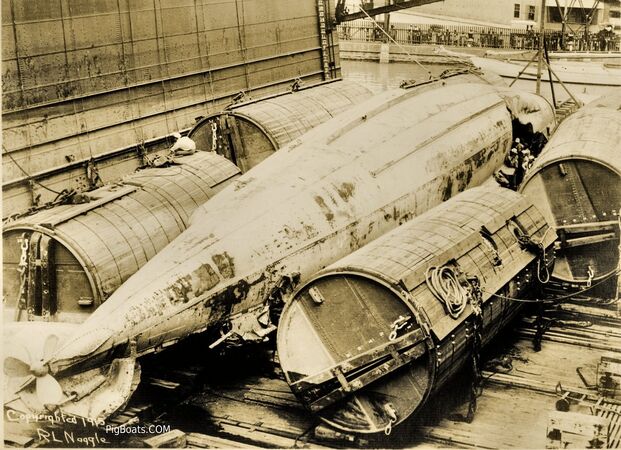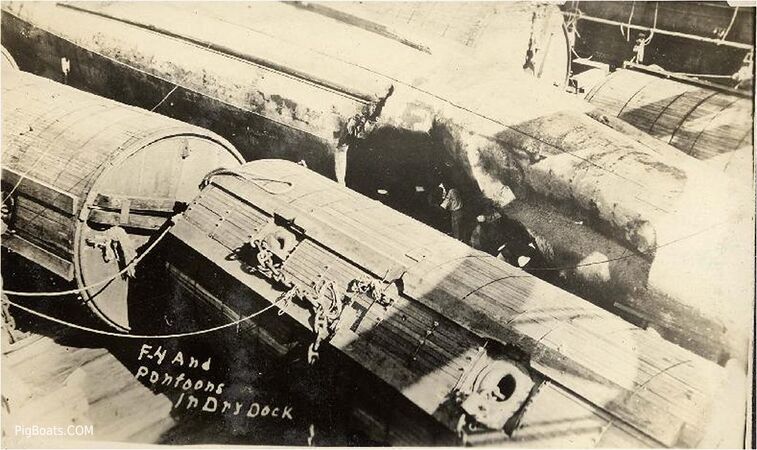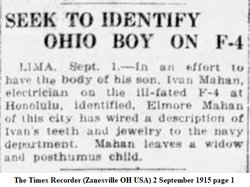F-4 salvage: Difference between revisions
Pbcjohnston (talk | contribs) Added captions |
Pbcjohnston (talk | contribs) |
||
| (45 intermediate revisions by 2 users not shown) | |||
| Line 1: | Line 1: | ||
[[File:F- | [[File:New Header F-class.jpg]] | ||
=== <big>The Crew</big> === | |||
<center> | |||
<div style="text-align: justify;"><span style="color:#00008B"> | |||
<gallery mode="packed" widths="200px" heights="300px"> | |||
File:F-4 Ashcroft.jpg|George T. Ashcroft, GM 1c | |||
File:F-4 Buck.jpg|Clark G. Buck, GM 2c | |||
File:F-4 Cauvin.jpg|[[Cauvin|'''Ernest C. Cauvin, MM 1c''']] | |||
File:F-4 Colwell.jpg|[[Colwell|'''Harley Colwell, CEM''']] | |||
File:F-4 Covington.jpg|Walter F. Covington, MM 1c | |||
File:F-4 Deeth.jpg|George L. Deeth, EM 1c | |||
File:F-4 Ede.jpg|[[Ede|'''Alfred L. Ede, LT, Commanding Officer''']] | |||
File:F-4 Gilman.jpg|Frederick Gilman, GM 1c | |||
File:F-4 Grindle.jpg|Aliston H. Grindle, CEM | |||
File:F-4 Herzog.jpg|Frank H. Herzog, EM 2c | |||
File:F-4 Hill.jpg|Edwin S. Hill, MM 1c | |||
File:F-4 Hughson.jpg|Francis M. Hughson, MM 1c | |||
File:F-4 Jennie.jpg|Albert F. Jennie, EM 2c | |||
File:F-4 Lunger.jpg|[[Joined Fates|'''Archie H. Lunger, GM 2c''']] | |||
File:F-4 Mahan.jpg|Ivan L. Mahan, MM 1c | |||
File:F-4 Moore.jpg|Horace L. Moore, GM 1c | |||
File:F-4 Nelson.jpg|William S. Nelson, CMM | |||
File:F-4 Parker.jpg|Timothy A. Parker, LT, Executive Officer | |||
File:F-4 Pierard.jpg|[[Joined Fates|'''Frank C. Pierard, CGM''']] | |||
File:F-4 Wells.jpg|Charles H. Wells, MM 2c | |||
File:F-4 Withers.jpg|Henry A. Withers, GM 1c | |||
</gallery> | |||
</center><br> | |||
<div style="text-align: justify;"><span style="color:#00008B">This was the last crew of the USS F-4. All of these men perished on March 25, 1915. Rest in peace shipmates. | |||
<small>Photos courtesy of On Eternal Patrol.com.</small> | |||
[[File:Red bar sub new.jpg]] | |||
[[File:F-4 crew before hawaii-1.jpg|left|500px]] | |||
This newspaper photo was taken prior to the F-4 sailing to San Pedro and then Hawaii. All but two of the men shown here were on that fateful last dive. Those two had already been transferred off the F-4 and sent to other vessels. They almost all seem to be puffing on cigars. The man highest in the photo, center, is Earnest Cauvin. It isn't known if the dog held by Edwin Hill is his own dog or possibly the sub's mascot. | |||
<small>Image provided by: Penn State University Libraries, University Park, PA. Evening Public Ledger, March 31, 1915</small> | |||
[[File:Red bar sub new.jpg]] | |||
[[File:F1crew F4crew-4.jpg|left|500px|Photo taken on deck of USS F-1 with 6 from F-4]] | |||
This photo of submarine crews contains six men from the ill-fated F-4. The photo appears to have been taken on the deck of the F-1. EM 1c George L. Deeth is the second man from right. To his right (camera left) is MM 1c Edwin Hill. On the other side of Deeth is MM 1c Francis M. Hughson. The man in the center with the coveralls is CEM Harley Colwell. The second man from left is GM 2c Archie H. Lunger. Seated, second from right is CGM Frank C. Pierard. The rest of the men are not identified and are no doubt F-1 crew members . This photo taken prior to March 25, 1915. Lunger & Pierard were Brother-in-laws, married to sisters. Pierard had children, Lungers wife was pregnant but he never got to see his child. Read their story [[Joined Fates|'''here''']]. | |||
The one F-1 known crew member is CMM John Peter Albert Messang seated first man on right. He was aboard the USS F-1 when it was in collision with the F-3 in 1917 and sank taking Messang and 18 other of the crew to their deaths. Three were saved. | |||
<small>Photo in the private collection of Ric Hedman.</small> | |||
[[File:Red bar sub new.jpg]] | |||
[[File:F-4 three crew.jpg|left|500px]] | |||
Newspaper photo posted in the Denver Post on March 29, 1915 showing three F-4 crewmen posing for the camera. The man on the left is believed to be MM 1c Edwin Hill. In the center is CEM Harley Colwell, with GM 2c Clark G. Buck on the right. | |||
<small>Photo from the family collection of George Myers who is a distant cousin of Clark Buck.</small> | |||
[[File:Red bar sub new.jpg]] | |||
<div style="text-align: justify;"><span style="color:#000000"> | |||
=== <big>Search for the Lost Boat</big> === | === <big>Search for the Lost Boat</big> === | ||
</div> | |||
[[File:F-4 salvage 1.jpg|left|500px]] | [[File:F-4 salvage 1.jpg|left|500px]] | ||
<div style="text-align: justify;"><span style="color:#00008B">Once it was realized that F-4 had not returned when it should, all manner of craft went out from Honolulu to search for the boat. It must be remembered that in 1915 Hawaii was an undeveloped paradise with little modern infrastructure. The F-boats were based in Honolulu because the base at Pearl Harbor was in its infancy and was not yet capable of supporting warships. In 1915 Hawaii was still a remote outpost. | <div style="text-align: justify;"><span style="color:#00008B">Once it was realized that F-4 had not returned when it should, all manner of craft went out from Honolulu to search for the boat. It must be remembered that in 1915 Hawaii was an undeveloped paradise with little modern infrastructure. The F-boats were based in Honolulu because the base at Pearl Harbor was in its infancy and was not yet capable of supporting warships. In 1915 Hawaii was still a remote outpost. | ||
Here | Here three men are in a very small rowboat. Two of them are using a box with a glass plate in the bottom that allowed a clearer view of things underwater. These boxes actually worked quite well, but only to view divers at shallower depths. The water at the wreck's original depth was far too deep for these men to see the wreck in any detail. | ||
<small>Photo in the private collection of Ric Hedman.</small> | <small>Photo in the private collection of Ric Hedman.</small> | ||
| Line 12: | Line 72: | ||
[[File:F-4 salvage 2.jpg|left|500px]] | [[File:F-4 salvage 2.jpg|left|500px]] | ||
<div style="text-align: justify;"><span style="color:#00008B">Early in the search the Navy was using every means to locate the lost submarine. All they had to go on was some air bubbles and oil. They began dragging grapples in hopes of snagging the lost vessel. These hopes were soared when a heavy object was hooked. It turned out to be the lost three and a half ton anchor from the battleship USS Oregon ( | <div style="text-align: justify;"><span style="color:#00008B">Early in the search the Navy was using every means to locate the lost submarine. All they had to go on was some air bubbles and oil. They began dragging grapples in hopes of snagging the lost vessel. These hopes were soared when a heavy object was hooked. It turned out to be the lost three and a half ton anchor from the battleship [http://www.navsource.net/archives/01/03a.htm '''USS Oregon (Battleship No. 3)''']. The Oregon lost her port anchor on May 30, 1901 due to a defective chain link. Chief Bosun J.E. Murphy was nearly killed when the link parted. Murphy was a hero in the Battle of Santiago during the Spanish-American War. | ||
According to the Board of Investigation Report, when | According to the Board of Investigation Report, when the anchor was discovered Chief Gunners Mate Jack Agraz, a Navy diver from the USS F-1, donned his gear and followed the line to the target. Three crews of four men each manned the hand turned air pump supplying air to him. He discovered the grapple chain was wrapped around "an old anchor" at 215 feet. The F-4 had not been found. | ||
<small>Photo in the private collection of Ric Hedman.</small> | <small>Photo in the private collection of Ric Hedman.</small> | ||
| Line 21: | Line 81: | ||
[[File:F-4 salvage 3.jpg|left|500px]] | [[File:F-4 salvage 3.jpg|left|500px]] | ||
<div style="text-align: justify;"><span style="color:#00008B">Another false alarm when part of the periscope was discovered. | <div style="text-align: justify;"><span style="color:#00008B">Another false alarm when part of the periscope was discovered. The newspaper article describes the early search that went on for the F-4 and the recovery of a portion of one of her periscopes. The highlighted section refers to an object in the F-4 Legacy section below. | ||
<small>Photo in the private collection of Ric Hedman.</small> | <small>Photo in the private collection of Ric Hedman.</small> | ||
| Line 28: | Line 88: | ||
[[File:F-4 salvage 7 agraz.jpg|left|500px]] | [[File:F-4 salvage 7 agraz.jpg|left|500px]] | ||
<div style="text-align: justify;"><span style="color:#00008B">Chief Gunners Mate (Torpedo) John "Jack" Agraz, USN was a diver and a crewmember on the F-4's sister boat F-1. Agraz would make dozens of dives during the search for F-4. He was a large and powerful man, with the constitution of an ox. His friends described him as fearless and determined, full of guts and stubbornness. He had been born in Guadalajara, Mexico in 1879 and had come to the United States in 1904 seeking adventure, which he found in the U.S. Navy. He made dives to over 200 feet with a Schrader Mk IV diving helmet and breastplate resting on his shoulders, ''without wearing a watertight diving suit or weights!'' He wore only long john underwear and a pair of deck shoes. He did not decompress on the way up (that was still a developing science) and never suffered from the bends. He was performing physical feats that astounded the men he worked with. His bravery was unquestioned. | <div style="text-align: justify;"><span style="color:#00008B">Chief Gunners Mate (Torpedo) John "Jack" Agraz, USN was a diver and a crewmember on the F-4's sister boat F-1. Agraz would make dozens of dives during the search for F-4. He was a large and powerful man, with the constitution of an ox. His friends described him as fearless and determined, full of guts and stubbornness. He had been born in Guadalajara, Mexico in 1879 and had come to the United States in 1904 seeking adventure, which he found in the U.S. Navy. He made dives to over 200 feet with a Schrader Mk IV diving helmet and breastplate resting on his shoulders, ''without wearing a watertight diving suit or weights!'' He wore only long john underwear and a pair of deck shoes. Without a watertight suit the water came up into the helmet, with the air pressure keeping the level just below his chin. He did not decompress on the way up (that was still a developing science) and never suffered from the bends. He was performing physical feats that astounded the men he worked with. His bravery was unquestioned. | ||
<small>Photo in the private collection of Ric Hedman.</small> | <small>Photo in the private collection of Ric Hedman.</small> | ||
| Line 42: | Line 102: | ||
[[File:F-4 salvage 5.jpg|left|500px]] | [[File:F-4 salvage 5.jpg|left|500px]] | ||
<div style="text-align: justify;"><span style="color:#00008B">A rather crowded diving launch hovering over the scene of F-4's sinking. Given the fact that none of the men appear to be operating the pump, it is | <div style="text-align: justify;"><span style="color:#00008B">A rather crowded diving launch hovering over the scene of F-4's sinking. Given the fact that none of the men appear to be operating the pump, it is unlikely that there is a diver in the water from this launch. The men are intently trying to peer though the water, with one man using a glass bottomed bucket to try to see better. Most of the diving on the F-4 was conducted from these launches, as there were no specialized salvage ships in Hawaii at that time. | ||
<small>Photo in the private collection of Ric Hedman.</small> | <small>Photo in the private collection of Ric Hedman.</small> | ||
| Line 49: | Line 109: | ||
[[File:F-4 salvage 6.jpg|left|500px]] | [[File:F-4 salvage 6.jpg|left|500px]] | ||
<div style="text-align: justify;"><span style="color:#00008B">Here is an interesting action photo. It appears that a diver has come to the surface (possibly Agraz) | <div style="text-align: justify;"><span style="color:#00008B">Here is an interesting action photo. It appears that a diver has come to the surface (possibly Agraz). His helmet and breast plate have been removed and he has slid back into the water. You can see his form just below the surface. One man has his arm into the water and looks to have a hold of him. A second man is reaching for him and everyone else is looking on in concern. Someone may have pulled the helmet off too early. | ||
<small>Photo in the private collection of Ric Hedman.</small> | <small>Photo in the private collection of Ric Hedman.</small> | ||
[[File:Red bar sub new.jpg]] | |||
<center> | |||
<gallery mode="packed" widths="600px" heights="800px"> | |||
File:F-4 newspaper article A.jpg | |||
File:F-4 newspaper article.jpg | |||
File:F-4 newspaper article C.jpg | |||
</gallery> | |||
</center> | |||
<div style="text-align: justify;"><span style="color:#00008B">This article is from the March 28, 1915 issue of The New York Times. It describes the feverish work that went on to try to raise the boat in the first few days, an ultimately vain effort to save the crew. No diver had yet actually made it to the sub, so the full extent of the damage was not known at this point. | |||
<small>Copyright The New York Times</small> | |||
[[File:Red bar sub new.jpg]] | [[File:Red bar sub new.jpg]] | ||
| Line 61: | Line 134: | ||
[[File:F-4 salvage 9.jpg|left|500px]] | [[File:F-4 salvage 9.jpg|left|500px]] | ||
<div style="text-align: justify;"><span style="color:#00008B">The F-4 was soon found and it was determined that the crew was lost. The Navy was determined to salvage the vessel, but deep water salvage was still very much a developing science and therefore they lacked the technical ability to do so. Naval Constructor LCDR Julius Furer was assigned to lead the effort and he determined that lifting the boat with pontoons was going to be the best method. Six pontoons had to be built at the Mare Island Navy Yard. This is a starboard quarter view of the Pennsylvania-class armored cruiser USS Maryland (Armored Cruiser No. 8) with the six specially made pontoons loaded aboard. The Maryland was standing by at Mare Island and as soon as the pontoons were ready they were loaded and the Maryland steamed at full speed to Hawaii with the cargo, along with a host of specialized salvage gear, diving equipment, and experienced deep-sea divers. There are four pontoons loaded aft and two loaded forward. | <div style="text-align: justify;"><span style="color:#00008B">The F-4 was soon found and it was determined that the crew was lost. The Navy was determined to salvage the vessel, but deep water salvage was still very much a developing science and therefore they lacked the technical ability to do so. Naval Constructor LCDR Julius Furer was assigned to lead the effort and he determined that lifting the boat with pontoons was going to be the best method. Six pontoons had to be built at the Mare Island Navy Yard. This is a starboard quarter view of the Pennsylvania-class armored cruiser [https://www.navsource.net/archives/04/acr8/acr8.htm '''USS Maryland (Armored Cruiser No. 8)'''] with the six specially made pontoons loaded aboard. The Maryland was standing by at Mare Island and as soon as the pontoons were ready they were loaded and the Maryland steamed at full speed to Hawaii with the cargo, along with a host of specialized salvage gear, diving equipment, and experienced deep-sea divers. There are four pontoons loaded aft and two loaded forward. | ||
<small>Photo in the private collection of Ric Hedman.</small> | <small>Photo in the private collection of Ric Hedman.</small> | ||
| Line 75: | Line 148: | ||
[[File:F-4 salvage 8.jpg|left|500px]] | [[File:F-4 salvage 8.jpg|left|500px]] | ||
<div style="text-align: justify;"><span style="color:#00008B">The dredge California was moved from | <div style="text-align: justify;"><span style="color:#00008B">The dredge California was moved from Pearl Harbor, where she was being used to deepen the harbor, to the F-4 location with thoughts she could raise the F-4. Ultimately, she was used to position the cables and chains under the F-4. She is seen here with the Young Brothers launch/tug Louise alongside and an unidentified tug in the background. | ||
<small>Photo in the private collection of Ric Hedman.</small> | <small>Photo in the private collection of Ric Hedman.</small> | ||
| Line 112: | Line 185: | ||
<center> | <center> | ||
<gallery mode="packed" widths=" | <gallery mode="packed" widths="300px" heights="200px"> | ||
File:F-4 salvage 14 pontoons 1.jpg | File:F-4 salvage 14 pontoons 1.jpg | ||
File:F-4 salvage 14 pontoons 2.jpg | File:F-4 salvage 14 pontoons 2.jpg | ||
| Line 121: | Line 194: | ||
</gallery> | </gallery> | ||
</center> | </center> | ||
<div style="text-align: justify;"><span style="color:#00008B">Pontoons can be tricky beasts to work with, and this series of photos show the efforts made by the salvage force lifting the F-4 from the bottom. Cables suspended below these pontoons were slung under the F-4, and once the water was forced out of the pontoons with compressed air, they physically lifted the F-4 off the bottom. In several of the photos a man can be seen standing on a pontoon wearing overalls and a bowler hat. That is Master Rigger Fred Busse, a member of Furer's team, supervising the rigging process. Note that many of the pontoons are not floating level, and balancing them was a constant headache. In several of the pictures the USS Navajo (Fleet Tug No. 52) is seen standing by to assist.</span> | <div style="text-align: justify;"><span style="color:#00008B">Pontoons can be tricky beasts to work with, and this series of photos show the efforts made by the salvage force lifting the F-4 from the bottom. Cables suspended below these pontoons were slung under the F-4, and once the water was forced out of the pontoons with compressed air, they physically lifted the F-4 off the bottom. In several of the photos a man can be seen standing on a pontoon wearing overalls and a bowler hat. That is Master Rigger Fred Busse, a member of Furer's team, supervising the rigging process. Note that many of the pontoons are not floating level, and balancing them was a constant headache. In several of the pictures the [https://www.navsource.net/archives/09/47/47052.htm '''USS Navajo (Fleet Tug No. 52)'''] is seen standing by to assist. | ||
In the third photo the small tug, behind the speeding launch, is the the Young Brothers "Louise", one of their small flotilla of commercial vessels for hire that was were used by the Navy in this salvage operations.</span> | |||
<small>Photos in the private collection of Ric Hedman.</small> | <small>Photos in the private collection of Ric Hedman.</small> | ||
| Line 131: | Line 206: | ||
In the center background is the Navy floating cantilever pontoon crane YD-25. The crane had a lifting rating of 150 tons. Too little to have lifted the flooded F-4. She was destined to become a visual fixture at Pearl Harbor for the next dozen years. | In the center background is the Navy floating cantilever pontoon crane YD-25. The crane had a lifting rating of 150 tons. Too little to have lifted the flooded F-4. She was destined to become a visual fixture at Pearl Harbor for the next dozen years. | ||
The tug, "Helen" from the Young Brothers Commercial fleet is escorting the F-4 in the background. | |||
In the left background the USS Maryland is moored. She is the vessel that brought the six lifting pontoons to Hawaii. | In the left background the USS Maryland is moored. She is the vessel that brought the six lifting pontoons to Hawaii. | ||
| Line 139: | Line 216: | ||
[[File:F-4 salvage 14 pontoons 9.jpg|left|500px]] | [[File:F-4 salvage 14 pontoons 9.jpg|left|500px]] | ||
<div style="text-align: justify;"><span style="color:#00008B">In a photo taken just a few minutes after the one above, the riggers are shown readjusting the lifting chains to the shortest amount so that the F-4 could fully enter the harbor and placed in drydock. | <div style="text-align: justify;"><span style="color:#00008B">In a photo taken just a few minutes after the one above, the riggers are shown readjusting the lifting chains to the shortest amount so that the F-4 could fully enter the harbor and be placed in drydock. The stern of the tug Helen can be seen at the left. | ||
<small>Photo in the private collection of Ric Hedman.</small> | <small>Photo in the private collection of Ric Hedman.</small> | ||
| Line 146: | Line 223: | ||
[[File:F-4 salvage 14 pontoons 8.jpg|left|500px]] | [[File:F-4 salvage 14 pontoons 8.jpg|left|500px]] | ||
<div style="text-align: justify;"><span style="color:#00008B">This is an artist's impression of what the F-4 looked like suspended below her lifting pontoons. The artist cleverly used the photo above as a start, then superimposed his own image below it. Yes, the F-4 was nearly upside down while it was being towed, as this was the position in which she hit the bottom after sinking. Unfortunately, the artist got the orientation wrong. She was actually laying on her | <div style="text-align: justify;"><span style="color:#00008B">This is an artist's impression of what the F-4 looked like suspended below her lifting pontoons. The artist cleverly used the photo above as a start, then superimposed his own image below it. Yes, the F-4 was nearly upside down while it was being towed, as this was the position in which she hit the bottom after sinking. Unfortunately, the artist got the orientation wrong. She was actually laying on her starboard side, not the port side as shown here. | ||
<small>Photo from ''Beneath the Surface: WWI Submarines Built in Seattle and Vancouver'' by Bill LIghtfoot.</small> | <small>Photo from ''Beneath the Surface: WWI Submarines Built in Seattle and Vancouver'' by Bill LIghtfoot.</small> | ||
| Line 170: | Line 247: | ||
[[File:F-4 salvage dd 1.jpg|left|500px]] | [[File:F-4 salvage dd 1.jpg|left|500px]] | ||
<div style="text-align: justify;"><span style="color:#00008B">Without a drydock of their own (the Pearl Harbor facilities were far from finished), the Navy was forced to contract with the Inter Island Steam Navigation Company for use of their drydock. It was located at the foot of Nu'uanu Avenue along Queen Street, what is now called Nimitz Highway (Rt 92). F-4 is shown here in the dock on August 31, 1915. A crowd of men has gathered to examine the remains of the boat. This view is looking at the nearly upside down F-4's bow, with pontoons on each side. Behind F-4 is the Hilo based tugboat Printer that had reserved dry dock time to repair her hull after a collision with one of her scows. | |||
At the time of the Navy contract the drydock had been reserved for the tug Printer, recently sold to Hilo businessman G. B. Marshall. He needed the tug to help to build the breakwater at Hilo Harbor for which he had won the contract. Printer needed some repairs after a collision with one of her rock hauling scows, and the new owners wired the dry dock and reserved space to have work done. When the F-4 was finally raised and moved to the dry dock there was room for the Printer to fit aft of her. It was expected the repairs to the Printer would require 24 hours of work night and day to get the rush job done, but with the F-4 now in the dock with her the work on Printer could proceed at a more leisurely pace. Note the scaffolding has yet to be put in place around the tug. | |||
<small>Newspaper photo.</small> | |||
[[File:Red bar sub new.jpg]] | |||
[[File:F-4 salvage dd 2.jpg|left|500px]] | [[File:F-4 salvage dd 2.jpg|left|500px]] | ||
<div style="text-align: justify;"><span style="color:#00008B">This photo was taken shortly after the one above, from a higher angle. The inspection and remains recovery process has just begun. | |||
<small>Photo in the private collection of Ric Hedman.</small> | |||
[[File:Red bar sub new.jpg]] | |||
[[File:F-4 salvage dd 3.jpg|left|500px]] | [[File:F-4 salvage dd 3.jpg|left|500px]] | ||
<div style="text-align: justify;"><span style="color:#00008B">A broad angle view of the entire drydock. The Inter Island Drydock was a floating drydock, meaning that it partially submerged to allow vessels to float over it. Ballast tanks in either side of the dock would then be pumped out, raising the dock and its vessels. | |||
<small>Photo in the private collection of Ric Hedman.</small> | |||
[[File:Red bar sub new.jpg]] | |||
[[File:F-4 salvage dd 4.jpg|left|500px]] | [[File:F-4 salvage dd 4.jpg|left|500px]] | ||
<div style="text-align: justify;"><span style="color:#00008B">Once the dock was fully out of the water, the full extent of the damage to the F-4 was visible for the first time. The implosion started in the overhead of the torpedo room, near the torpedo loading hatch. It was a natural weak point in the structure where two hull plates were riveted together. The hull collapsed inward, the nearly 150 psi of water pressure knocking a huge hole in the pressure hull. Further collapse was stopped only by the rapid flooding of the rest of the boat. | |||
In this view the boat is upside down, with the port side facing up, looking at the bow. The strake like object at the top is the port side bilge keel, with the main keel just to the right of that. It is important to understand that the leaking battery acid did not cause the implosion. The battery acid weakened the bottom of the hull structure, causing a leak which made the boat heavy, quickly resulting in a loss of control. It was when the boat exceeded crush depth that the hull imploded. | |||
Admiral Clifford J. Boush, Commandant of the 14th Naval District in Hawaii, is seen in the foreground, wearing the long white coat. | |||
<small>Photo in the private collection of Ric Hedman.</small> | |||
[[File:Red bar sub new.jpg]] | |||
[[File:F-4 salvage dd 5.jpg|left|500px]] | [[File:F-4 salvage dd 5.jpg|left|500px]] | ||
[[File:F-4 salvage dd 6.jpg| | <div style="text-align: justify;"><span style="color:#00008B">Once all the excitement died down the Navy let several photographers in to record the damages. The man at the right looks to be operating a movie camera. | ||
[[File: | <small>Photo in the private collection of Ric Hedman.</small> | ||
[[File:Red bar sub new.jpg]] | |||
<center> | |||
<gallery mode="packed" widths="400px" heights="300px"> | |||
File:F-4 salvage dd 6.jpg|<small>Photo in the private collection of Ric Hedman.</small> | |||
File:F-4 salvage dd 7.jpg|<small>Photo courtesy of Mike Dilley, whose father, Homer 'Pat' Dilley, sailed aboard the USS F-2.</small> | |||
</gallery> | |||
</center> | |||
<div style="text-align: justify;"><span style="color:#00008B">Two more views of the F-4 in drydock, from different angles. The men standing near the implosion hole give scale to the size of the hole. | |||
[[File:Red bar sub new.jpg]] | |||
[[File:F-4 salvage dd 9.jpg|left|500px]] | [[File:F-4 salvage dd 9.jpg|left|500px]] | ||
<div style="text-align: justify;"><span style="color:#00008B">A view from aft, showing damage to the rudder, stern planes, and propellers. The stern planes and rudders have been torn away during the salvage effort. The ram for the planes and rudders can be seen under the right-hand propeller. The skeg for holding the lower rudder is twisted almost 90 degrees to port. | |||
These newly installed experimental propellers were of a special design that were intended for low RPM and high efficiency. It is thought that at high speeds they would have done little to drive the submarine to the surface. The official report stated that these propellers ''"were the secondary cause of the disaster"'' by providing insufficient water flow over the stern planes and thus negatively impacting the control of the vessel. | |||
<small>Photo in the private collection of Ric Hedman.</small> | |||
[[File:Red bar sub new.jpg]] | |||
[[File:F-4 salvage dd 10.jpg|left|500px]] | [[File:F-4 salvage dd 10.jpg|left|500px]] | ||
<div style="text-align: justify;"><span style="color:#00008B">A sailor, who appears to be a second class petty officer, stands alongside the F-4. He has a pretty grim look on his face. Could be a sailor from one of the other F-class submarines. | |||
The extensive damage to the after end of the submarine is very evident. Remembering that the submarine is almost upside down, the twisted piece of metal to the left and twisted towards the camera is actually part of the upper skeg running from the deck to the rudder. It has been bent over more than 90 degrees. The blades of the screws have been bent over and a huge chip has been made in the blade of the screw. | |||
<small>Photo in the private collection of Ric Hedman.</small> | |||
[[File:Red bar sub new.jpg]] | |||
[[File:F-4 salvage dd 8.jpg|left|500px]] | |||
<div style="text-align: justify;"><span style="color:#00008B">In a photo taken several days later, if you look closely you can see that the bent propellers have been removed from the shafts. A large hull plate has been removed from the engine room area to facilitate the removal of the bodies of the crew. Most of the crew took refuge there as fumes and water filled the rest of the boat, but quickly died when the watertight door failed under pressure. There is also a smaller hole on the bottom (top) of the submarine, perhaps to pump fuel out of tanks. | |||
<small>Photo in the private collection of Ric Hedman.</small> | |||
[[File:Red bar sub new.jpg]] | |||
[[File:F-4 salvage exhaust.jpg|left|500px]] | [[File:F-4 salvage exhaust.jpg|left|500px]] | ||
<div style="text-align: justify;"><span style="color:#00008B">What remains of the port engine exhaust system, exposed after the superstructure was ripped away by the salvage efforts. | |||
<small>Photo in the private collection of Ric Hedman.</small> | |||
[[File:Red bar sub new.jpg]] | |||
[[File:F-4 salvage dd 11.jpg|left|500px]] | [[File:F-4 salvage dd 11.jpg|left|500px]] | ||
<div style="text-align: justify;"><span style="color:#00008B">A close up of the implosion damage to the F-4's hull. It looks like crumpled tin foil, such was the force of the implosion. Note the frayed mass of hemp mooring lines still in their below deck locker, stowed there on the morning March 25, 1915 when the boat got underway for its final voyage. | |||
<small>Photo in the private collection of Ric Hedman.</small> | |||
[[File:Red bar sub new.jpg]] | |||
[[File:F-4 salvage dd 12.jpg|left|500px]] | [[File:F-4 salvage dd 12.jpg|left|500px]] | ||
<div style="text-align: justify;"><span style="color:#00008B">A very rare photo taken of the forlorn F-4 in drydock. The photo was taken by an unauthorized civilian. The dock was located in downtown Honolulu right off Queen St. (now Nimitz Highway), so it was difficult for the Navy and the Marines to control civilian access to the sensitive wreckage. There is a note on the back indicating that the photographer nearly got his camera smashed by a guard and that he was quickly run off the premises. | |||
This photo shows the F-4 with her bow cap rotated to line up with two of her four torpedo tubes. This was done so that the weapons in the tubes could be removed. To access the other two tubes the cap was rotated to the right. To completely close all four tubes the cap was rotated so that the openings were vertical and behind the stem. | |||
<small>Photo in the private collection of Ric Hedman.</small> | |||
[[File:Red bar sub new.jpg]] | [[File:Red bar sub new.jpg]] | ||
[[File:F-4 salvage battery.jpg|left|500px]] | |||
<div style="text-align: justify;"><span style="color:#00008B">An interior photo taken after salvage showing the battery plates falling out of the battery. Plates were positioned in the battery box and held in place the proper distance with small precisely made wooded wedges. When the vessel was turned over the weight of the lead plates against the wooden decking covering the battery was too much and the planks were ripped off the top of the battery well. Being underwater the sulfuric acid mixed with the salt water and escaped as a cloud of bubbles. | |||
<small>Photo in the private collection of Ric Hedman.</small> | |||
[[File:Red bar sub new.jpg]] | |||
[[File:F-4 salvage engine room door.jpg|left|500px]] | |||
<div style="text-align: justify;"><span style="color:#00008B">This view is in the control room, looking aft at the bulkhead that divides it from the engine room. The empty cells of the after battery well are visible in the upper right. The door was ripped apart when it imploded into the engine room. As the boat was sinking, many of the crew sought refuge in the engine room in a vain attempt to save their lives. It may have also been an attempt to move weight aft to counteract the effect of flooding in the forward battery well. At any rate, the door did not hold for long after the torpedo room implosion, collapsing a few seconds later, killing the remainder of the crew. | |||
<small>Photo in the private collection of Ric Hedman.</small> | |||
[[File:Red bar sub new.jpg]] | |||
<div style="text-align: justify;"><span style="color:#000000"> | |||
=== <big>Post Salvage</big> === | === <big>Post Salvage</big> === | ||
</div> | |||
[[File:F-4 hoggett.jpg|left|500px]] | [[File:F-4 hoggett.jpg|left|500px]] | ||
<div style="text-align: justify;"><span style="color:#00008B">[[Hoggett|'''James Morton Hoggett, Electrician's Mate 3rd Class''']], was the only member of the F-4 crew to not die that fateful day. | |||
On March 25, 1915 he was left ashore when the F-4 went out on her fateful morning dive. It was a habit for the early submarines to leave one man ashore as a watchman, perhaps to keep an eye on ships material left on the dock and to be a contact person for any information that needs to be reported to the vessel as soon as it returns to port. This was the days before ship radios became common. It happened to be his turn this day. | |||
In most all of the the news reports after the sinking reported he was on shore leave at the time instead of being the "watchman". There was one other man who escaped the sinking, Arthur Mellien, a Chief Machinist Mate, who transferred off the F-4 a few days prior to the sinking. | |||
In the aftermath of the sinking, Hoggett seems to have developed symptoms of PTSD. Accounts of his doings and happenings after the sinking show he seems to have become fairly reckless in his activities and had a number of close to death encounters. Of course nothing was known about PTSD at that time. | |||
He left the Navy in 1916 and when WWI came around he enlisted in the Army Tank Corps in 1918. He survived the war. | |||
James Hoggett died May 31, 1952 in Rolla, MO. He had served on the USS Pensacola, Pittsburgh, Oregon, Maryland, Pennsylvania, the Alert, (a submarine tender), the F-4 and the USS Constellation before being discharged. He was a lucky person to have lived out a normal life span that his shipmates on the F-4 were denied. | |||
<small>Photo in the private collection of Ric Hedman.</small> | |||
[[File:Red bar sub new.jpg]] | |||
[[File:F-4 auto blow system.jpg|left|500px]] | [[File:F-4 auto blow system.jpg|left|500px]] | ||
<div style="text-align: justify;"><span style="color:#00008B">The F-class submarines had an automatic ballast tank blowing system set to send the submarine to the surface if the sub descended below 100 feet. It was determined by the commission that investigated the sinking that the initial casualty happened above 100 feet. This system was euphemistically referred to as the "plow". | |||
The drawing above was made of the F-4 Automatic Blow System after recovery. It shows the setup and condition of the system made by the crew at the time of the disaster. Short of actually being able to talk to the crew it shows the steps they had taken in the few moments available to them. | |||
This system is something akin to today's Emergency Blow system brought about by the sinking of the USS Thresher (SSN-593) in 1963, although the F-4's system was automatic, whereas the modern system must be manually actuated. | |||
<small>Image from the National Archives.</small> | |||
[[File:Red bar sub new.jpg]] | [[File:Red bar sub new.jpg]] | ||
[[File:F-4 newspaper article 2.jpg|left|600px]] | |||
<div style="text-align: justify;"><span style="color:#00008B">Navy personnel quickly removed the bodies of the crew, and investigators swarmed the wreck, gathering data to use in the investigation. F-4 was also stripped of any equipment useful to the other F-boats. | |||
File:F-4 newspaper article | |||
The Navy was under a time crunch, as they had to vacate the drydock in order to get the other three F-boats in the drydock for repairs. They had been damaged, but not sunk, when they were accidentally rammed by the USS Supply, a Navy ship, while nested together at their pier in Honolulu Harbor. The F-2 was the most badly damaged but she, in turn crashed into the F-1 and F3 causing them damage as well. They also had to let the tug that was in the dock behind the sub out since its repairs were long completed. | |||
On the evening of September 14, 1915 she was refloated once again, suspended from her pontoons. The tug Navajo towed her up the coast to Pearl Harbor. Navajo took her to what was then a backwater section of the harbor called Magazine Loch. She towed F-4 into the loch until she grounded in the soft mud. She was left there until the investigation was complete. The Navy dithered as to what to do with the sub, so it was decided to just leave her where she sat. On November 25 the pontoon chains were cast loose and the F-4 was allowed to settle into the soft mud of the bottom of the loch. | |||
<div style="text-align: justify;"><span style="color:#00008B"> | She is still there to this day. In 1940 she was rolled into a trench dredged in the loch bottom to make way for the expansion of docks at the submarine base. She sits at an angle of 43.5 degrees true about 40 feet off the Sierra 13 mooring, roughly parallel to the old shore line (see below). | ||
Why the Navy never properly disposed of the wreck by scrapping (like [[Notable Submarine Accidents|'''the S-51''']]) or by towing her to deep water and sinking her (like the [http://www.navsource.net/archives/01/maine1.htm '''USS Maine''']) is a bit of a mystery. The webmasters have speculated that the Navy wanted to retain the wreck in an accessible location as evidence until potential future legal proceedings had a chance to play themselves out. Perhaps once it became apparent that there was not going to be any further need to retain the wreck it was decided that doing anything with it was not worth the expense. | |||
<small>Clipping courtesy of the Honolulu Star-Bulletin.</small> | |||
[[File:Red bar sub new.jpg]] | [[File:Red bar sub new.jpg]] | ||
[[File:F-4 resting spot.jpg|left|500px]] | [[File:F-4 resting spot.jpg|left|500px]] | ||
<div style="text-align: justify;"><span style="color:#00008B">The location circled above is the approximate location for the ex-USS F-4's hull. The unfinished nature of the Submarine Base is visible in this photo from the late 1920's showing the future area of expansion that will involve the hulk of the F-4. The two S-class submarines are moored to the "Sierra 12" mooring. | |||
Note in the background that at this point that only a narrow causeway connects the main part of the Submarine Base to Kuahua Island. As the base rapidly expanded in the 1930's and 1940's this area would be completely filled in and Kuahua would no longer be an islet. | |||
<small>National Archives photo.</small> | |||
[[File:Red bar sub new.jpg]] | |||
[[File:F-4 chart.jpg|left|500px]] | [[File:F-4 chart.jpg|left|500px]] | ||
<div style="text-align: justify;"><span style="color:#00008B">A page from a Navy publication of the late 1920's. This is of Magazine Loch and shows water depths in preparation for the expansion of the Submarine Base northeastward. Drawn in is the location of the F-4 hull as it laid at the time of disposal on the loch floor. The numbers show how deep the loch was at that time. The depths are in feet. It was determined that F-4 was in the way of the pier expansion plans so a trench was dredged just to the left of her and the wreck was pushed into it. This made the wreck deep enough that it would not interfere with anything above. | |||
<small>Photo in the private collection of Ric Hedman.</small> | |||
[[File:Red bar sub new.jpg]] | [[File:Red bar sub new.jpg]] | ||
[[File:F-4 Magazine Loch snip.jpg|left|500px]] | |||
<div style="text-align: justify;"><span style="color:#00008B">A snip from MS Maps showing the present day configuration of Magazine Loch. The F-4's hull sits in a trench directly below where the small tug pushing the barge is, right at the end of the right hand pier. | |||
[[File:Red bar sub new.jpg]] | |||
<div style="text-align: justify;"><span style="color:#000000"> | |||
=== <big>F-4 Legacy</big> === | === <big>F-4 Legacy</big> === | ||
</div> | |||
[[File:F-4 funeral 1.jpg|left|500px]] | [[File:F-4 funeral 1.jpg|left|500px]] | ||
<div style="text-align: justify;"><span style="color:#00008B">Once the removal for the crew's remains was completed and the process of identification was completed a memorial ceremony was held on September 9th. Four men had been identified and the remaining bodies were placed in four coffins for transport to Arlington National Cemetery. The remains were escorted in a funeral cortege through the streets of Honolulu to the docks. The eight coffins were loaded on the Navy ship USS Supply that sailed later that day for California. | |||
<small>Photo courtesy of the USS Bowfin Submarine Museum and Park.</small> | |||
[[File:Red bar sub new.jpg]] | |||
[[File:F-4 funeral 2.jpg|left|500px]] | [[File:F-4 funeral 2.jpg|left|500px]] | ||
<div style="text-align: justify;"><span style="color:#00008B">A funeral cortege through the streets of Washington D.C. happened to take place at the same time as the 50 year reunion and convention of the ending of the Civil War. Both Union and Confederate veterans, numbering over 60,000, were present in the city and most turned out to honor the men of the F-4 as the procession made its way to Arlington. | |||
Four of the F-4 crew had been identified and were laid to rest separately at locations chosen by their families. | |||
<small>Newspaper photo.</small> | |||
[[File:Red bar sub new.jpg]] | |||
[[File:F-4 funeral 3.jpg|left|500px]] | [[File:F-4 funeral 3.jpg|left|500px]] | ||
<div style="text-align: justify;"><span style="color:#00008B">The original headstone installed at the Arlington National Cemetary by the Navy in 1915. This stone was later relocated to Pearl Harbor at the site of the F-4 hull burial. | |||
<small>Photo in the private collection of Ric Hedman.</small> | |||
[[File:Red bar sub new.jpg]] | |||
[[File:F-4 funeral 4.jpg|left|500px]] | [[File:F-4 funeral 4.jpg|left|500px]] | ||
[[File:F-4 funeral 5.jpg|left|500px]] | <div style="text-align: justify;"><span style="color:#00008B">The replacement headstone installed at the insistence of submarine veterans in the year 2000. The full story of the two headstones can be read [http://militaryhonors.sid-hill.us/history/f4-hist3.htm '''at this link.'''] | ||
[[File:F-4 funeral 6.jpg|left|500px]] | |||
[[File:F-4 funeral 7.jpg|left|500px]] | <small>Photo in the private collection of Ric Hedman.</small> | ||
[[File:F-4 funeral 8.jpg|left|500px]] | |||
[[File:Red bar sub new.jpg]] | |||
[[File:F-4 funeral 5.jpg|left|500px|courtesy of William Dornick.]] | |||
[[File:F-4 Ashcroft.jpg|Courtesy of On Eternal Patrol.]] | |||
<div style="text-align: justify;"><span style="color:#00008B">George Ashcroft was buried at the Mare Island Naval Cemetery at the request of his family. He and Ivan Mahan are buried side by side, shipmates forever. | |||
<small>Photo courtesy of William Dornick</small> | |||
[[File:Red bar sub new.jpg]] | |||
[[File:F-4 funeral 6.jpg|left|500px|Courtesy of findagrave.com]] | |||
[[File:F-4 Mahan.jpg|Courtesy of On Eternal Patrol.]] | |||
[[File:F-4 Mahan clipping.jpg]] | |||
<div style="text-align: justify;"><span style="color:#00008B">Ivan Mahan at rest at the Mare Island Naval Cemetary next to his shipmate George Ashcroft. | |||
<small>Photo courtesy of FindAGrave</small> | |||
[[File:Red bar sub new.jpg]] | |||
[[File:F-4 funeral 7.jpg|left|500px|Courtesy of findagrave.com]] | |||
[[File:F-4 Herzog.jpg|Courtesy of On Eternal Patrol.]] | |||
<div style="text-align: justify;"><span style="color:#00008B">Son of Nephi Herzog and Louisa Maria Miller (Herzog). | |||
<br><br>Newspaper Article - ''The body of Frank N. Herzog, bluejacket, who went down with submarine F-4 in Honolulu Harbor in March, arrived in Salt Lake (City) on September 23, after a long journey which began at Honolulu seventeen days previous. Herzog's home was in Salt Lake (City). | |||
Soda Springs Sun; Soda Springs, Idaho. | |||
September 30, 1915; Page Three.'' | |||
<small>Photo courtesy of FindAGrave</small> | |||
[[File:Red bar sub new.jpg]] | |||
[[File:F-4 funeral 8.jpg|left|500px|Courtesy of findagrave.com]] | |||
[[File:F-4 Wells.jpg|Courtesy of On Eternal Patrol.]] | |||
<div style="text-align: justify;"><span style="color:#00008B">Charles Harris Wells, ''Gone but not forgotten'' say his loved ones. | |||
Buried in Elmwood Cemetery, Norfolk, Virginia, USA, Plot ELM EXT, Block 6 Lot 4 Sp 1S | |||
<small>Photo courtesy of FindAGrave</small> | |||
[[File:Red bar sub new.jpg]] | |||
[[File:F-4 periscope section 1.jpg|left|500px]] | [[File:F-4 periscope section 1.jpg|left|500px]] | ||
<div style="text-align: justify;"><span style="color:#00008B">This is believed to be a section of the periscope reported recovered at the same time that the battleship anchor during the early phases of the search for the F-4 off Honolulu Harbor on March 29, 1915. According to the tape measure it stands a little shy of 16 inches in height and is reported to be four inches in diameter. Unfortunately, for some reason it has been made into a memorial cup by a previous owner. When or who did this is not known, and the authenticity of the object can not be empirically verified. Any research on this will be welcome by myself and Dr. Newby, the owner of the object. | |||
<small>Photo courtesy of Dr. Terrell Newby.</small> | |||
[[File:Red bar sub new.jpg]] | |||
[[File:F-4 periscope section 2.jpg|left|500px]] | [[File:F-4 periscope section 2.jpg|left|500px]] | ||
<div style="text-align: justify;"><span style="color:#00008B">Close-up of the engraving on what is believed to be a section of the periscope reported recovered on March 29, 1915. | |||
<small>Photo courtesy of Dr. Terrell Newby.</small> | |||
[[File:Red bar sub new.jpg]] | [[File:Red bar sub new.jpg]] | ||
Latest revision as of 14:26, 18 June 2025
The Crew
-
George T. Ashcroft, GM 1c
-
Clark G. Buck, GM 2c
-
Walter F. Covington, MM 1c
-
George L. Deeth, EM 1c
-
Frederick Gilman, GM 1c
-
Aliston H. Grindle, CEM
-
Frank H. Herzog, EM 2c
-
Edwin S. Hill, MM 1c
-
Francis M. Hughson, MM 1c
-
Albert F. Jennie, EM 2c
-
Ivan L. Mahan, MM 1c
-
Horace L. Moore, GM 1c
-
William S. Nelson, CMM
-
Timothy A. Parker, LT, Executive Officer
-
Charles H. Wells, MM 2c
-
Henry A. Withers, GM 1c
Photos courtesy of On Eternal Patrol.com.

This newspaper photo was taken prior to the F-4 sailing to San Pedro and then Hawaii. All but two of the men shown here were on that fateful last dive. Those two had already been transferred off the F-4 and sent to other vessels. They almost all seem to be puffing on cigars. The man highest in the photo, center, is Earnest Cauvin. It isn't known if the dog held by Edwin Hill is his own dog or possibly the sub's mascot.
Image provided by: Penn State University Libraries, University Park, PA. Evening Public Ledger, March 31, 1915
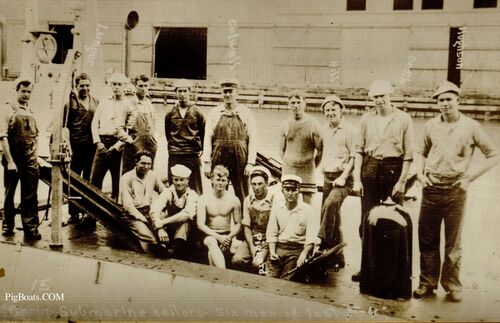
This photo of submarine crews contains six men from the ill-fated F-4. The photo appears to have been taken on the deck of the F-1. EM 1c George L. Deeth is the second man from right. To his right (camera left) is MM 1c Edwin Hill. On the other side of Deeth is MM 1c Francis M. Hughson. The man in the center with the coveralls is CEM Harley Colwell. The second man from left is GM 2c Archie H. Lunger. Seated, second from right is CGM Frank C. Pierard. The rest of the men are not identified and are no doubt F-1 crew members . This photo taken prior to March 25, 1915. Lunger & Pierard were Brother-in-laws, married to sisters. Pierard had children, Lungers wife was pregnant but he never got to see his child. Read their story here.
The one F-1 known crew member is CMM John Peter Albert Messang seated first man on right. He was aboard the USS F-1 when it was in collision with the F-3 in 1917 and sank taking Messang and 18 other of the crew to their deaths. Three were saved.
Photo in the private collection of Ric Hedman.

Newspaper photo posted in the Denver Post on March 29, 1915 showing three F-4 crewmen posing for the camera. The man on the left is believed to be MM 1c Edwin Hill. In the center is CEM Harley Colwell, with GM 2c Clark G. Buck on the right.
Photo from the family collection of George Myers who is a distant cousin of Clark Buck.
Search for the Lost Boat
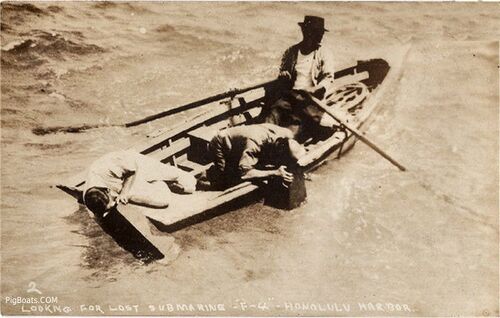
Here three men are in a very small rowboat. Two of them are using a box with a glass plate in the bottom that allowed a clearer view of things underwater. These boxes actually worked quite well, but only to view divers at shallower depths. The water at the wreck's original depth was far too deep for these men to see the wreck in any detail.
Photo in the private collection of Ric Hedman.
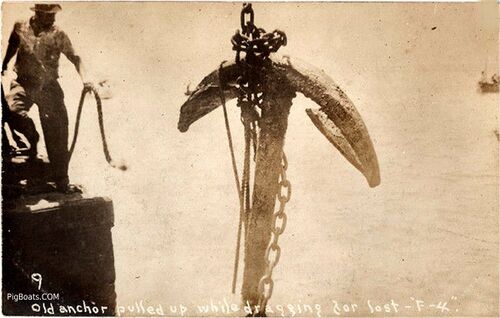
According to the Board of Investigation Report, when the anchor was discovered Chief Gunners Mate Jack Agraz, a Navy diver from the USS F-1, donned his gear and followed the line to the target. Three crews of four men each manned the hand turned air pump supplying air to him. He discovered the grapple chain was wrapped around "an old anchor" at 215 feet. The F-4 had not been found.
Photo in the private collection of Ric Hedman.

Photo in the private collection of Ric Hedman.

Photo in the private collection of Ric Hedman.
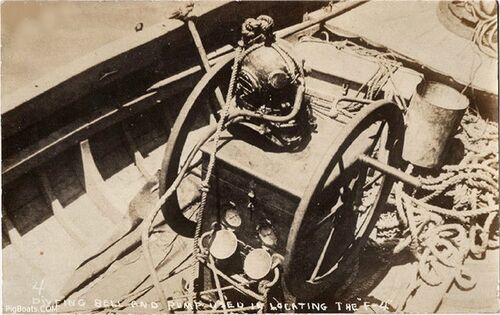
Photo in the private collection of Ric Hedman.
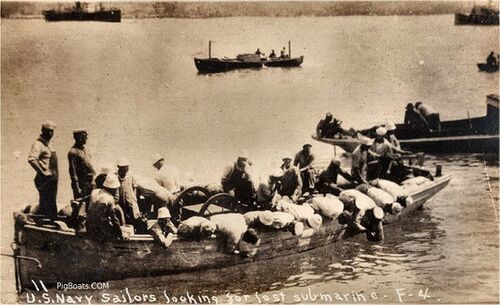
Photo in the private collection of Ric Hedman.

Photo in the private collection of Ric Hedman.
Copyright The New York Times
Salvage Work

Photo in the private collection of Ric Hedman.
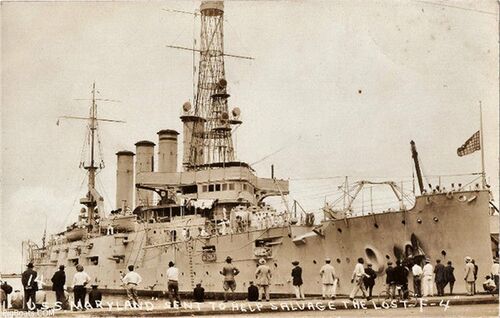
Photo in the private collection of Ric Hedman.

Photo in the private collection of Ric Hedman.
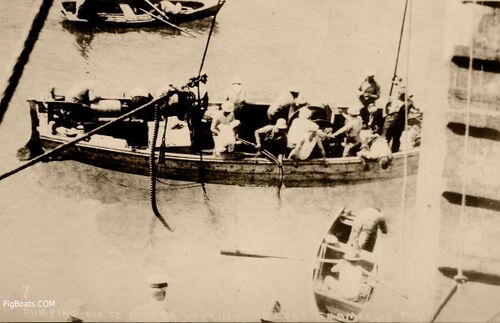
Photo in the private collection of Ric Hedman.
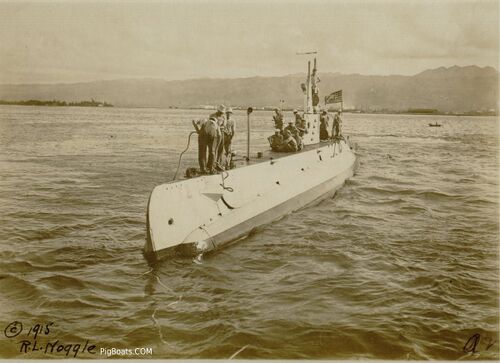
The rope that is being worked on by the men on deck can be seen floating in the water in front of the submarine. There is a similar one stretching from the after deck to what is assumed to be the salvage barge. The F-2 is probably in the process of mooring to that barge to supply the air needed for the pontoons.
Note the proximity to the shore. The F-4 sank just outside of the entrance to Honolulu Harbor, in Mamala Bay. With Oahu essentially being the top of an underwater mountain, the water depth drops off precipitously as soon as you leave the harbor.
Photo in the private collection of Ric Hedman.
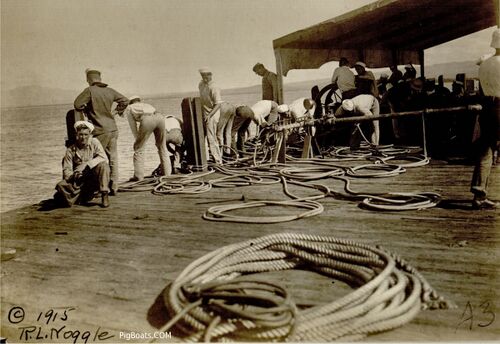
Photo in the private collection of Ric Hedman.
Raising the Boat with Pontoons
In the third photo the small tug, behind the speeding launch, is the the Young Brothers "Louise", one of their small flotilla of commercial vessels for hire that was were used by the Navy in this salvage operations.
Photos in the private collection of Ric Hedman.

In the center background is the Navy floating cantilever pontoon crane YD-25. The crane had a lifting rating of 150 tons. Too little to have lifted the flooded F-4. She was destined to become a visual fixture at Pearl Harbor for the next dozen years.
The tug, "Helen" from the Young Brothers Commercial fleet is escorting the F-4 in the background.
In the left background the USS Maryland is moored. She is the vessel that brought the six lifting pontoons to Hawaii.
Newspaper photo.

Photo in the private collection of Ric Hedman.
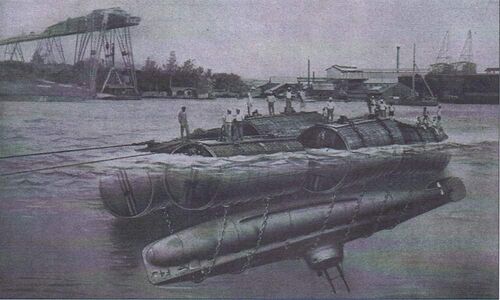
Photo from Beneath the Surface: WWI Submarines Built in Seattle and Vancouver by Bill LIghtfoot.
Photos in the private collection of Ric Hedman.
In Drydock

At the time of the Navy contract the drydock had been reserved for the tug Printer, recently sold to Hilo businessman G. B. Marshall. He needed the tug to help to build the breakwater at Hilo Harbor for which he had won the contract. Printer needed some repairs after a collision with one of her rock hauling scows, and the new owners wired the dry dock and reserved space to have work done. When the F-4 was finally raised and moved to the dry dock there was room for the Printer to fit aft of her. It was expected the repairs to the Printer would require 24 hours of work night and day to get the rush job done, but with the F-4 now in the dock with her the work on Printer could proceed at a more leisurely pace. Note the scaffolding has yet to be put in place around the tug.
Newspaper photo.

Photo in the private collection of Ric Hedman.
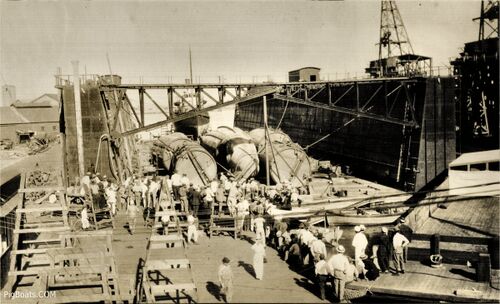
Photo in the private collection of Ric Hedman.
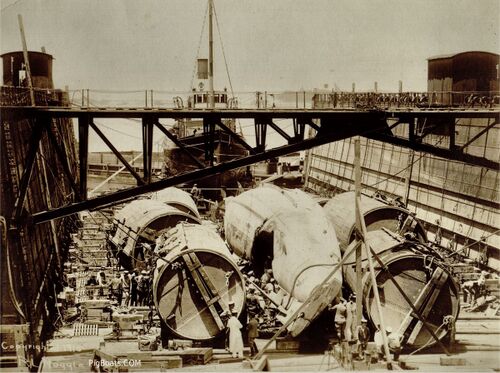
In this view the boat is upside down, with the port side facing up, looking at the bow. The strake like object at the top is the port side bilge keel, with the main keel just to the right of that. It is important to understand that the leaking battery acid did not cause the implosion. The battery acid weakened the bottom of the hull structure, causing a leak which made the boat heavy, quickly resulting in a loss of control. It was when the boat exceeded crush depth that the hull imploded.
Admiral Clifford J. Boush, Commandant of the 14th Naval District in Hawaii, is seen in the foreground, wearing the long white coat.
Photo in the private collection of Ric Hedman.
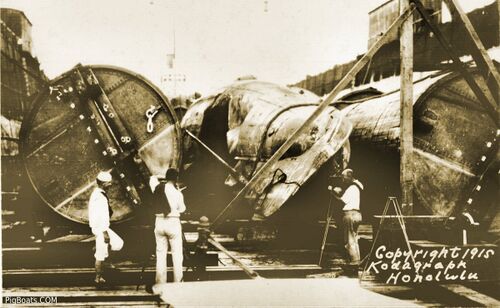
Photo in the private collection of Ric Hedman.
-
Photo in the private collection of Ric Hedman.
-
Photo courtesy of Mike Dilley, whose father, Homer 'Pat' Dilley, sailed aboard the USS F-2.
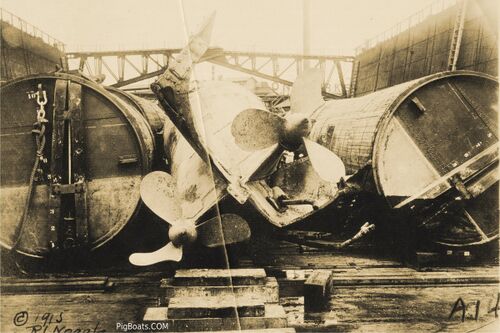
These newly installed experimental propellers were of a special design that were intended for low RPM and high efficiency. It is thought that at high speeds they would have done little to drive the submarine to the surface. The official report stated that these propellers "were the secondary cause of the disaster" by providing insufficient water flow over the stern planes and thus negatively impacting the control of the vessel.
Photo in the private collection of Ric Hedman.

The extensive damage to the after end of the submarine is very evident. Remembering that the submarine is almost upside down, the twisted piece of metal to the left and twisted towards the camera is actually part of the upper skeg running from the deck to the rudder. It has been bent over more than 90 degrees. The blades of the screws have been bent over and a huge chip has been made in the blade of the screw.
Photo in the private collection of Ric Hedman.
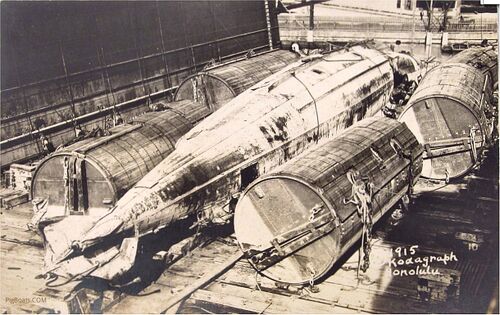
Photo in the private collection of Ric Hedman.

Photo in the private collection of Ric Hedman.
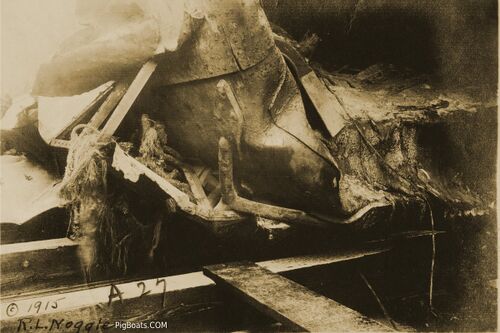
Photo in the private collection of Ric Hedman.

This photo shows the F-4 with her bow cap rotated to line up with two of her four torpedo tubes. This was done so that the weapons in the tubes could be removed. To access the other two tubes the cap was rotated to the right. To completely close all four tubes the cap was rotated so that the openings were vertical and behind the stem.
Photo in the private collection of Ric Hedman.
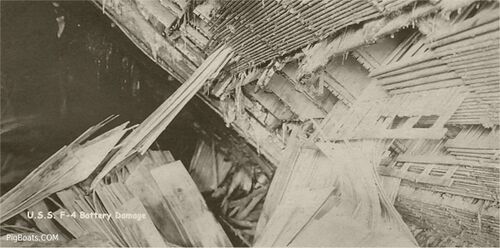
Photo in the private collection of Ric Hedman.
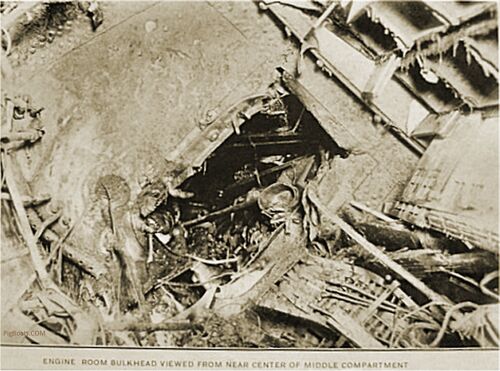
Photo in the private collection of Ric Hedman.
Post Salvage
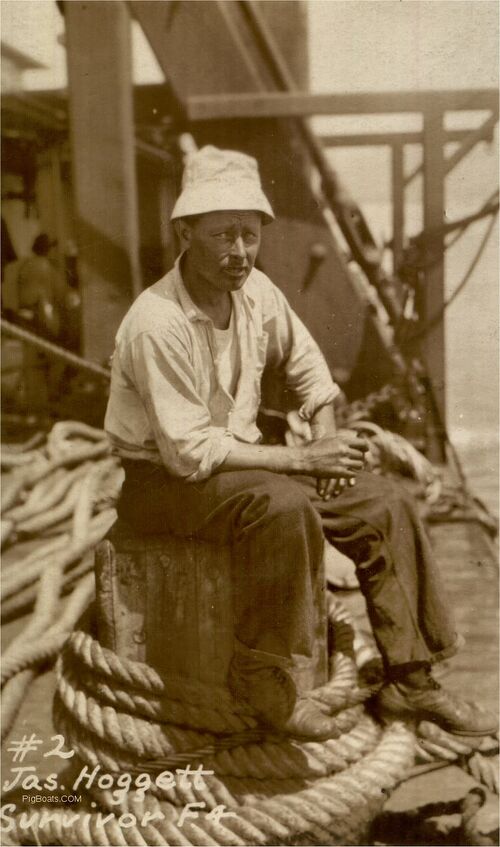
On March 25, 1915 he was left ashore when the F-4 went out on her fateful morning dive. It was a habit for the early submarines to leave one man ashore as a watchman, perhaps to keep an eye on ships material left on the dock and to be a contact person for any information that needs to be reported to the vessel as soon as it returns to port. This was the days before ship radios became common. It happened to be his turn this day.
In most all of the the news reports after the sinking reported he was on shore leave at the time instead of being the "watchman". There was one other man who escaped the sinking, Arthur Mellien, a Chief Machinist Mate, who transferred off the F-4 a few days prior to the sinking.
In the aftermath of the sinking, Hoggett seems to have developed symptoms of PTSD. Accounts of his doings and happenings after the sinking show he seems to have become fairly reckless in his activities and had a number of close to death encounters. Of course nothing was known about PTSD at that time.
He left the Navy in 1916 and when WWI came around he enlisted in the Army Tank Corps in 1918. He survived the war.
James Hoggett died May 31, 1952 in Rolla, MO. He had served on the USS Pensacola, Pittsburgh, Oregon, Maryland, Pennsylvania, the Alert, (a submarine tender), the F-4 and the USS Constellation before being discharged. He was a lucky person to have lived out a normal life span that his shipmates on the F-4 were denied.
Photo in the private collection of Ric Hedman.

The drawing above was made of the F-4 Automatic Blow System after recovery. It shows the setup and condition of the system made by the crew at the time of the disaster. Short of actually being able to talk to the crew it shows the steps they had taken in the few moments available to them.
This system is something akin to today's Emergency Blow system brought about by the sinking of the USS Thresher (SSN-593) in 1963, although the F-4's system was automatic, whereas the modern system must be manually actuated.
Image from the National Archives.
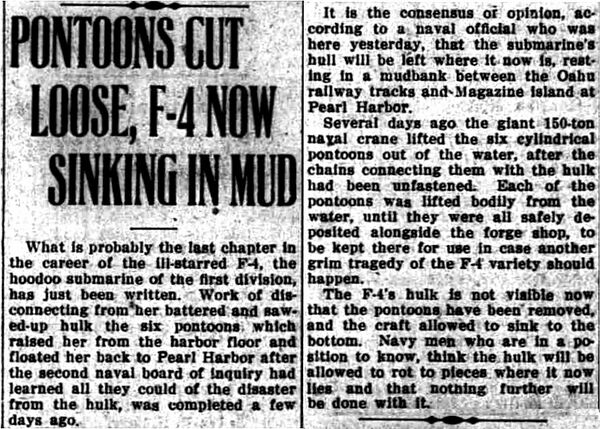
The Navy was under a time crunch, as they had to vacate the drydock in order to get the other three F-boats in the drydock for repairs. They had been damaged, but not sunk, when they were accidentally rammed by the USS Supply, a Navy ship, while nested together at their pier in Honolulu Harbor. The F-2 was the most badly damaged but she, in turn crashed into the F-1 and F3 causing them damage as well. They also had to let the tug that was in the dock behind the sub out since its repairs were long completed.
On the evening of September 14, 1915 she was refloated once again, suspended from her pontoons. The tug Navajo towed her up the coast to Pearl Harbor. Navajo took her to what was then a backwater section of the harbor called Magazine Loch. She towed F-4 into the loch until she grounded in the soft mud. She was left there until the investigation was complete. The Navy dithered as to what to do with the sub, so it was decided to just leave her where she sat. On November 25 the pontoon chains were cast loose and the F-4 was allowed to settle into the soft mud of the bottom of the loch.
She is still there to this day. In 1940 she was rolled into a trench dredged in the loch bottom to make way for the expansion of docks at the submarine base. She sits at an angle of 43.5 degrees true about 40 feet off the Sierra 13 mooring, roughly parallel to the old shore line (see below).
Why the Navy never properly disposed of the wreck by scrapping (like the S-51) or by towing her to deep water and sinking her (like the USS Maine) is a bit of a mystery. The webmasters have speculated that the Navy wanted to retain the wreck in an accessible location as evidence until potential future legal proceedings had a chance to play themselves out. Perhaps once it became apparent that there was not going to be any further need to retain the wreck it was decided that doing anything with it was not worth the expense.
Clipping courtesy of the Honolulu Star-Bulletin.
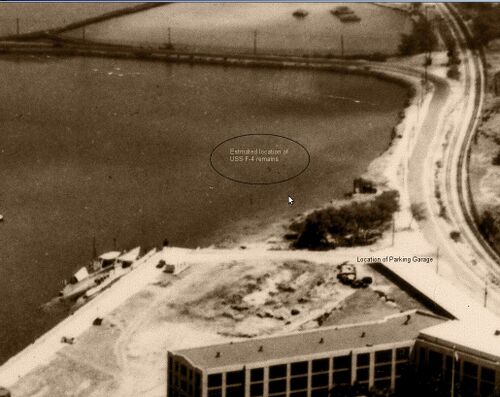
Note in the background that at this point that only a narrow causeway connects the main part of the Submarine Base to Kuahua Island. As the base rapidly expanded in the 1930's and 1940's this area would be completely filled in and Kuahua would no longer be an islet.
National Archives photo.
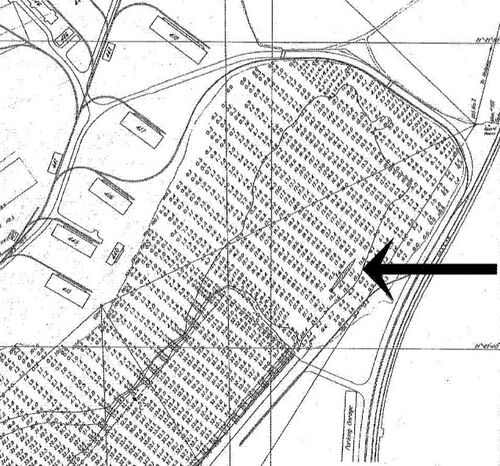
Photo in the private collection of Ric Hedman.
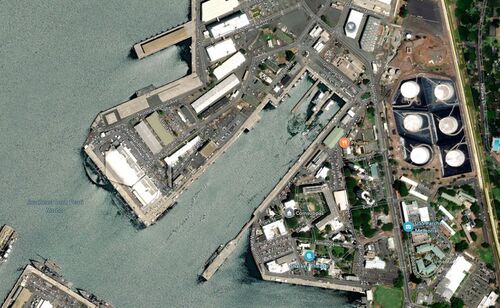
F-4 Legacy
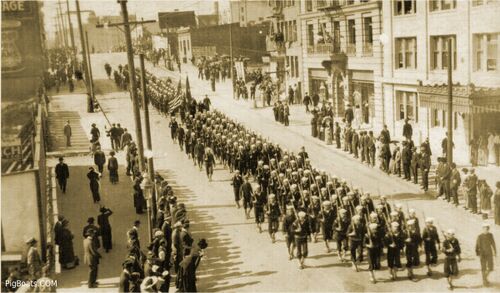
Photo courtesy of the USS Bowfin Submarine Museum and Park.

Four of the F-4 crew had been identified and were laid to rest separately at locations chosen by their families.
Newspaper photo.

Photo in the private collection of Ric Hedman.

Photo in the private collection of Ric Hedman.
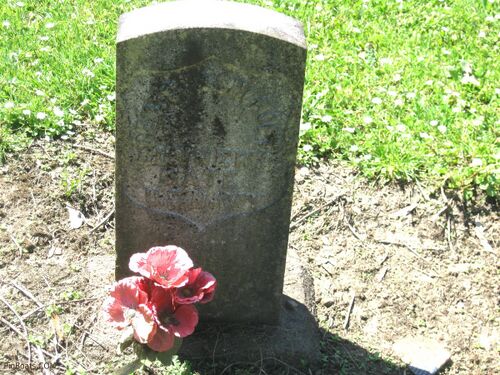
Photo courtesy of William Dornick
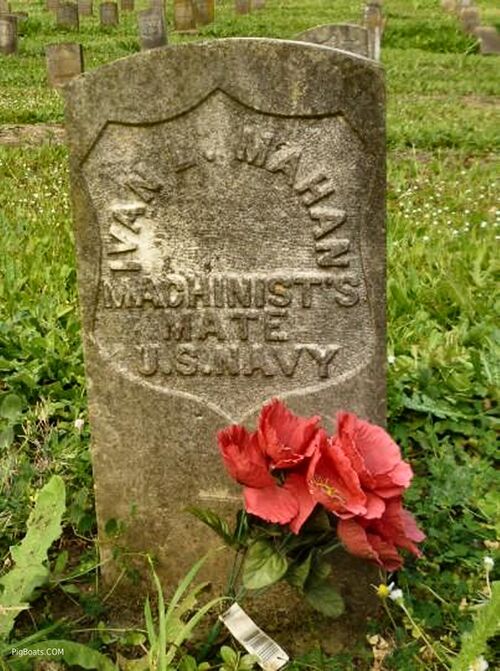
Photo courtesy of FindAGrave
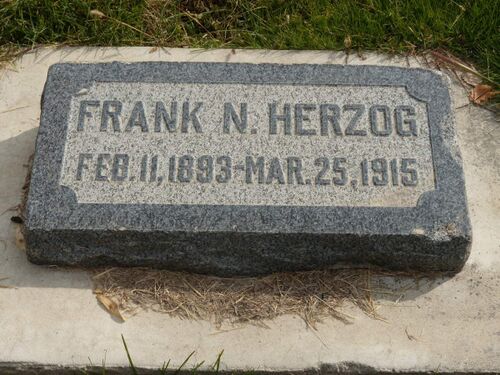
Newspaper Article - The body of Frank N. Herzog, bluejacket, who went down with submarine F-4 in Honolulu Harbor in March, arrived in Salt Lake (City) on September 23, after a long journey which began at Honolulu seventeen days previous. Herzog's home was in Salt Lake (City).
Soda Springs Sun; Soda Springs, Idaho. September 30, 1915; Page Three.
Photo courtesy of FindAGrave
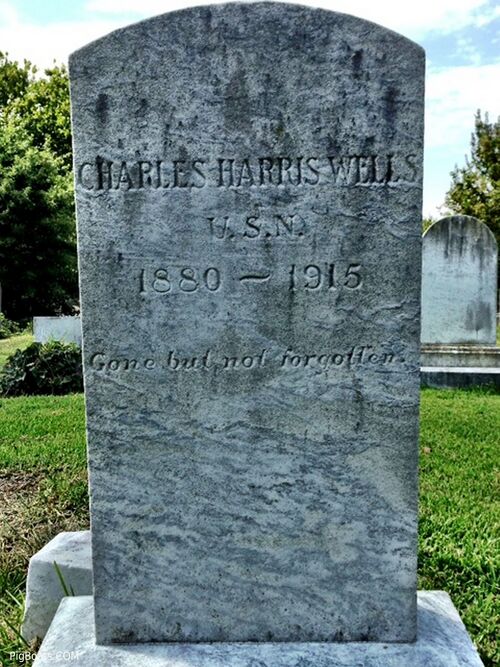
Buried in Elmwood Cemetery, Norfolk, Virginia, USA, Plot ELM EXT, Block 6 Lot 4 Sp 1S
Photo courtesy of FindAGrave
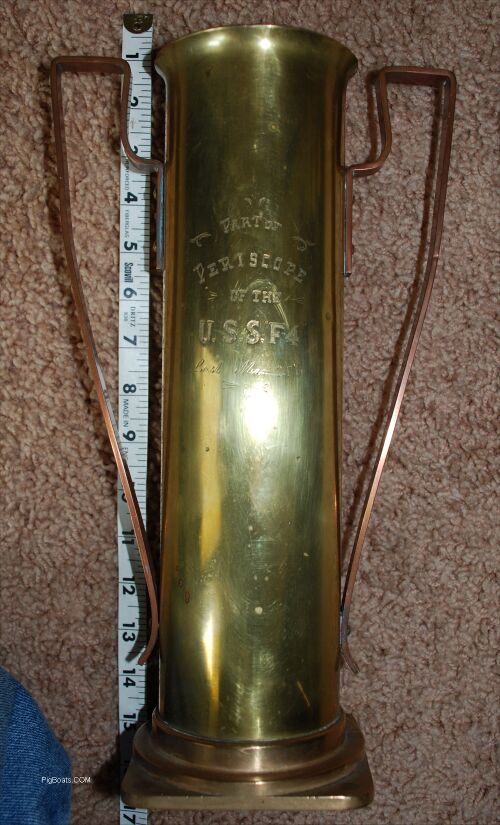
Photo courtesy of Dr. Terrell Newby.
